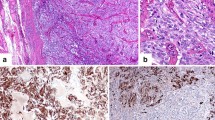Abstract
Background and aims
Patients with sporadic medullary thyroid carcinoma (MTC) have a variable clinical course. Our aim was to analyse the reduction of tumour markers after thyroidectomy with meticulous dissection and relate it to clinical outcome.
Materials and methods
Twenty consecutive patients with palpable sporadic MTC underwent thyroidectomy with central and uni- or bilateral modified radical neck dissection; three were subjected to mediastinal dissection. Basal (b-) and stimulated (s-) calcitonin (CT) and carcinoembryonic antigen (CEA)-levels were measured before and 6–8 weeks after primary surgery, and the reduction of these tumour markers was determined.
Results
Median CT (b- and s-) were markedly reduced after surgery (98.5% and 99.1%, respectively), and CEA decreased 11 times. CT (b-) fell >99% in seven patients after surgery; in these and four additional patients, CT (s-) showed a similar reduction. During follow-up (median 52.5 months), two patients (stages IV B and C) died of MTC; they had <95% reduction of CT. Four patients (stage IV A) are alive with verified metastases. Eight patients (one stage III, seven stage IV A) are alive with hypercalcitoninemia. Five stages I–III patients and one stage IV A patient are disease-free.
Conclusions
Thyroidectomy and meticulous dissection caused a pronounced reduction of tumour markers. A postoperative reduction of CT (s-) ≥97% seems to be associated with less aggressive clinical course, while CEA had lower predictive value.
Similar content being viewed by others
References
Machens A, Hauptmann S, Dralle H (2007) Increased risk of lymph node metastasis in multifocal hereditary and sporadic medullary thyroid cancer. World J Surg 31:1960–1965
Osamura RY, Yasuda O, Kawakami T, Itoh Y, Inada K, Kakudo K (1997) Immunoelectron microscopic demonstration of regulated pathway for calcitonin and constitutive pathway for carcinoembryonic antigen in the same cells of human medullary carcinomas of thyroid glands. Mod Pathol 10:7–11
Girelli ME, Nacamulli D, Pelizzo MR, De Vido D, Mian C, Piccolo M, Busnardo B (1998) Medullary thyroid carcinoma: clinical features and long-term follow-up of seventy-eight patients treated between 1969 and 1986. Thyroid 8:517–523
Gharib H, McConahey WM, Tiegs RD, Bergstralh EJ, Goellner JR, Grant CS, van Heerden JA, Sizemore GW, Hay ID (1992) Medullary thyroid carcinoma: clinicopathologic features and long-term follow-up of 65 patients treated during 1946 through 1970. Mayo Clin Proc 67:934–940
Modigliani E, Cohen R, Campos JM, Conte-Devolx B, Maes B, Boneu A, Schlumberger M, Bigorgne JC, Dumontier P, Leclerc L, Corcuff B, Guilhem I (1998) Prognostic factors for survival and for biochemical cure in medullary thyroid carcinoma: results in 899 patients. The GETC Study Group. Groupe d’étude des tumeurs à calcitonine. Clin Endocrinol 48:265–273
Hundahl SA, Cady B, Cunningham MP, Mazzaferri E, McKee RF, Rosai J, Shah JP, Fremgen AM, Stewart AK, Hölzer S (2000) Initial results from a prospective cohort study of 5583 cases of thyroid carcinoma treated in the united states during 1996. U.S. and German Thyroid Cancer Study Group. An American College of Surgeons Commission on Cancer Patient Care Evaluation study. Cancer 89:202–217
Moley JF, Fialkowski EA (2007) Evidence-based approach to the management of sporadic medullary thyroid carcinoma. World J Surg 31:946–956
Moley JF, DeBenedetti MK (1999) Patterns of nodal metastases in palpable medullary thyroid carcinoma: recommendations for extent of node dissection. Ann Surg 229:880–887
Machens A, Gimm O, Ukkat J, Hinze R, Schneyer U, Dralle H (2000) Improved prediction of calcitonin normalization in medullary thyroid carcinoma patients by quantitative lymph node analysis. Cancer 88:1909–1915
Weber T, Schilling T, Frank-Raue K, Colombo-Benkmann M, Hinz U, Ziegler R, Klar E (2001) Impact of modified radical neck dissection on biochemical cure in medullary thyroid carcinomas. Surgery 130:1044–1049
Scollo C, Baudin E, Travagli JP, Caillou B, Bellon N, Leboulleux S, Schlumberger M (2003) Rationale for central and bilateral lymph node dissection in sporadic and hereditary medullary thyroid cancer. J Clin Endocrinol Metab 88:2070–2075
Fleming JB, Lee JE, Bouvet M, Schultz PN, Sherman SI, Sellin RV, Friend KE, Burgess MA, Cote GJ, Gagel RF, Evans DB (1999) Surgical strategy for the treatment of medullary thyroid carcinoma. Ann Surg 230:697–707
Gimm O, Ukkat J, Dralle H (1998) Determinative factors of biochemical cure after primary and reoperative surgery for sporadic medullary thyroid carcinoma. World J Surg 22:562–567
Pelizzo MR, Boschin IM, Bernante P, Toniato A, Piotto A, Pagetta C, Nibale O, Rampin L, Muzzio PC, Rubello D (2007) Natural history, diagnosis, treatment and outcome of medullary thyroid cancer: 37 years experience on 157 patients. Eur J Surg Oncol 33:493–497
Tisell LE, Oden A, Muth A, Altiparmak G, Mölne J, Ahlman H, Nilsson O (2003) The Ki67 index a prognostic marker in medullary thyroid carcinoma. Br J Cancer 89:2093–2097
Laure Giraudet A, Al Ghulzan A, Aupérin A, Leboulleux S, Chehboun A, Troalen F, Dromain C, Lumbroso J, Baudin E, Schlumberger M (2008) Progression of medullary thyroid carcinoma: assessment with calcitonin and carcinoembryonic antigen doubling times. Eur J Endocrinol 158:239–246
TNM classification of malignant tumours (2002) Wiley-Liss, New York
Busnardo B, Girelli ME, Simioni N, Nacamulli D, Busetto E (1984) Nonparallel patterns of calcitonin and carcinoembryonic antigen levels in the follow-up of medullary thyroid carcinoma. Cancer 53:278–285
Wells SA Jr, Haagensen DE Jr, Linehan WM, Farrell RE, Dilley WG (1978) The detection of elevated plasma levels of carcinoembryonic antigen in patients with suspected or established medullary thyroid carcinoma. Cancer 42:1498–1503
Machens A, Ukkat J, Hauptmann S, Dralle H (2007) Abnormal carcinoembryonic antigen levels and medullary thyroid cancer progression: a multivariate analysis. Arch Surg 142:289–293
Miccoli P, Minuto MN, Ugolini C, Molinaro E, Basolo F, Berti P, Pinchera A, Elisei R (2007) Clinically unpredictable prognostic factors in the outcome of medullary thyroid cancer. Endocr Relat Cancer 14:1099–1105
Author information
Authors and Affiliations
Corresponding author
Additional information
None of the authors reported any conflict of interest.
Best of Endocrine Surgery in Europe 2008.
Rights and permissions
About this article
Cite this article
Bümming, P., Ahlman, H., Nilsson, B. et al. Can the early reduction of tumour markers predict outcome in surgically treated sporadic medullary thyroid carcinoma?. Langenbecks Arch Surg 393, 699–703 (2008). https://doi.org/10.1007/s00423-008-0375-6
Received:
Accepted:
Published:
Issue Date:
DOI: https://doi.org/10.1007/s00423-008-0375-6




